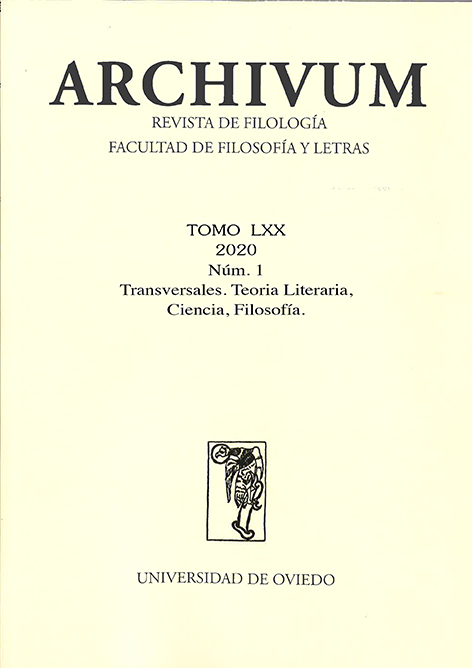Abstract
This paper connects Gilbert Durand’s thinking and cognitivist theories in their application to theory of literature. It reviews specifically the notions of image scheme by Mark Johnson and poetic iconicity by Margaret Freeman under the theoretical perspectives developed by Durand in the middle of the 20th century. These perspectives are enriched by conclusions drawn in present neuroaesthetics and semiotics, which search for biological grounds in their study of cultural phenomena, and also of poetic language, a field close to our interest. The final aim of this paper is to show the necessity of paying attention to the material, biologic and psychophysiological aspects acting upon the formation of symbols and language and their connection to the sentimental aspects, a concoction that until current cognitivism had been undervalued by critical paradigms of cartesian dualism.References
Aristóteles (2004) Poética, trad. gr. A. Villar Lecumberri, Madrid, Alianza.
Bermúdez, V. (2017) Ciencia y modulación del pensamiento poético: Percepción, emoción y metáfora en la escritura de Lorand Gaspar, Salamanca, Universidad de Salamanca.
Durand, G. (1981) Las estructuras antropológicas de lo imaginario.
Introducción a la arquetipología general, trad. fr. Mauro Armiño, Madrid, Taurus.
Durand. G. (2007) La imaginación simbólica, trad. fr. Marta Rojzman, Buenos Aires, Amorrortu.
Freeman, M. (2012) “Blending and Beyond: Form and Feeling in Poetic Iconicity”; en Jaén, I. y Jacques Simon, J. (eds.), Cognitive Literary Studies. Current Themes and New Directions, Austin, University of Texas, 127-143.
Gallese, V. (2019) “Embodied Simulation. Its Bearing on Aesthetic Experience and the Dialogue between Neuroscience and the Humanities”, en Gestalt Theory, 38, en prensa.
Gamoneda, A. (2016) Del animal poema. Olvido García-Valdés y la poética de lo vivo, Oviedo, KRK.
Gambino, R. y Pulvirenti, G. (2018) Storie Menti Mondi. Approccio neuroermeneutico alla letteratura, Milán, Mimesis.
González de Ávila, M. (2015) “La razón vital de la semiótica”; en Espectro de la analogía. Literatura & Ciencia, Madrid, Abadá, 177-216.
Johnson, M. (1990) The Body in the Mind. The Bodily Basis of Meaning, Imagination, and Reason, Chicago, University of Chicago Press.
Rivière, P. (2006) “Arquetipo”; en Servier, J (dir.) Diccionario de esoterismo, Madrid, Akal, 220-221.
Rosemblum, B. y Kuttner, F. (2011) Quantum enigma. Physics Encounters Consciousness, Nueva York, Oxford University Press.
Trejo Hernández, R.E. (2015) La imaginación y el tarot. Una clasificación de sus símbolos a partir de la teoría de lo imaginario de Gilbert Durand, Tesis Doctoral, México, Universidad Nacional Autónoma de México.
Turner, M. (1996) The Literary Mind, Nueva York, Oxford University Press.
Turner, M. (2014) The Origin of Ideas. Blending, Creativity, and the Human Spark, Oxford, University Press.
Zeki, S. (2009) Splendors and Miseries of the Brain. Love, Creativity, and the Quest for Human Happiness, Oxford, Wiley-Blackwell.

